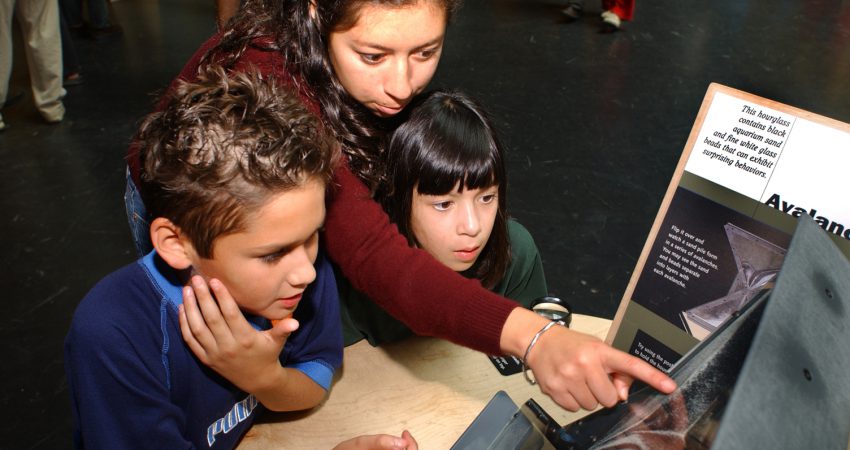
By Suzanne Perin - November 2013
PAPER CITATION
Alibali, M. W., & Nathan, M. J. (2012). Embodiment in mathematics teaching and learning: Evidence from learners’ and teachers’ gestures. Journal of the Learning Sciences, 21(2), 247–286.
Research Brief
How do gestures show what teachers and learners are communicating and understanding about mathematics as they work together? Starting with gestures that have identifiable meanings in psychological and cognitive theory, the authors applied these gestures to instances of mathematics teaching and learning, classifying them into three categories:
- Pointing gestures link spoken words and phrases to actual objects or persons that may or may not be present in the physical setting. Pointing gestures can convey relationships between mathematical ideas; they can reflect and affect a learner’s uptake of lesson content. Teachers most often point sequentially, for example, pointing at one rectangle followed by another rectangle. However, simultaneous pointing—for example, pointing at two rectangles at the same time—may help students to integrate disparate pieces of information. For example, the authors describe an instance of a teacher pointing concurrently at two rectangles to convey which sides are similar, even though one rectangle was longer than the other. In another example, a pointing gesture revealed a boy’s thinking while he explained how he would solve an equation at the blackboard. He touched both sides of the equation, indicating his awareness of the two sides. However, he did not then mention the two sides in his solution procedure—thus giving the teacher an opportunity to notice that he wasn’t sure how to use his developing understanding of the equation.
- Representational gestures enhance spoken content, either literally or metaphorically. They may use motions, such as turning an imaginary key when talking of starting a car, or shapes, such as a forearm angled to demonstrate the slope of a line or two hands forming a right angle. Behavioral and neuropsychological evidence shows that such representations are involved in language comprehension and in the formulation and manipulation of mental images, regardless of whether people have actually experienced what they are speaking about or can only imagine it. Alibali and Nathan posit that these gestures both convey meaning to listeners and help the speaker’s thinking process.
- Metaphorical gestures commonly used in everyday experiences express a sense of movement in space. In spoken language, examples of this kind of metaphor are expressions like “things are looking up,” where “up” indicates something good, or “his health is declining” where worsening illness is “down.” In a mathematical example, addition is explained as “putting two and two together,” so that arithmetic might be thought of as way of gathering or distributing objects (p. 255). Like the spoken phrases, metaphorical gestures are inherently spatial or deal with movement. For example, a hand first held close to the chest and then moved away from the body can represent numbers along a line relative to zero, where the body is zero. A caveat: Metaphorical gestures and their meanings are not always universal. In different languages and cultures, certain gestures may have very different connotations.
Gestures reveal thinking that goes beyond what is being said aloud. When gestures are considered in conjunction with speech, a richer understanding of the other’s thinking becomes possible.
Theoretical Basis
Theories of embodied cognition are based on the idea that cognition and linguistic processes are rooted in human perception and in the physical interactions of the human body with the world. Our basic ways of thinking, the ways we represent knowledge, and our methods of organizing and expressing information are shaped by the constraints and possibilities of human bodies and human perception. The particular line of theory from which these researchers draw concerns how thought is grounded in the physical world. Connecting new or abstract ideas to something more concrete and familiar facilitates meaning making and supports transfer of learning to new situations. (See pp. 250–251 of the article for more.)
Implications for Practice
Bodily movements are often considered invaluable in informal learning environments. The typology outlined in this article calls attention to the particular meanings or roles that specific gestures play in relation to mathematics learning. In their discussion, the authors call for special attention to the pedagogical nature of teachers’ oral and gestural communication. They suggest that just as much attention and planning should go into the use of gesture as is paid to oral delivery and classroom discussion—a recommendation that is equally valid for educators in out-of-school settings. In the evaluation or assessment of learning in informal settings because movement is often encouraged and designed into activities, attention to learners’ gestural interpretation may be even more important in revealing thinking and understanding than it is in schools, where standard paper-and-pencil forms of assessment are more widely used.




